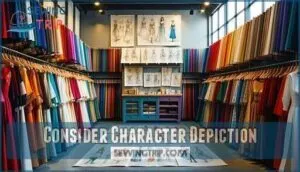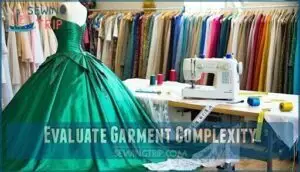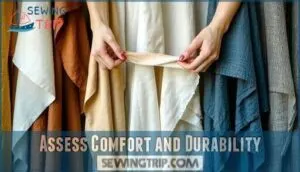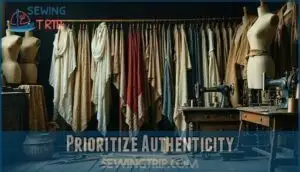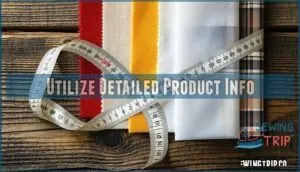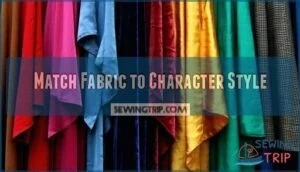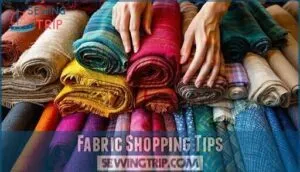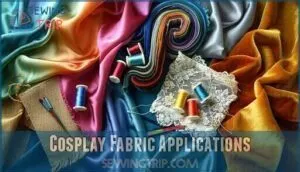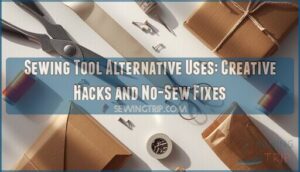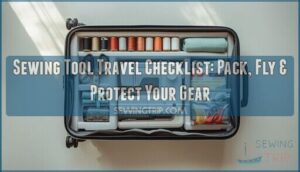This site is supported by our readers. We may earn a commission, at no cost to you, if you purchase through links.
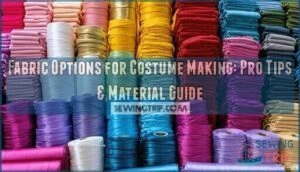
Cotton works beautifully for everyday heroes and historical characters, offering breathability and easy washing.
Spandex and lycra blends are your best friends for superheroes and form-fitting costumes, providing stretch and movement.
For armor-like appearances, consider metallic fabrics or structured materials like canvas.
Satin and silk create elegant flowing effects for fantasy characters, while denim and wool suit rugged adventurers.
Don’t overlook specialty fabrics like vinyl for futuristic looks or fleece for cozy creatures.
The secret lies in understanding how different textures photograph and move under stage lights.
Table Of Contents
Key Takeaways
- Match fabric to character needs: You’ll want cotton for everyday heroes and historical characters, spandex for superheroes requiring stretch and movement, and specialty materials like metallic fabrics for armor-like appearances.
- Consider construction complexity and skill level: You should choose forgiving fabrics like cotton or polyester blends for intricate designs, while matching your fabric selection to your sewing abilities and pattern difficulty.
- Prioritize comfort and durability for long wear: You’ll need to evaluate fabric weight, breathability, and seam strength to ensure you’re comfortable during extended convention days and multiple uses.
- Research authenticity and test materials first: You should study your character’s era and style requirements, always order fabric swatches before purchasing, and consider how different textures photograph under stage lights.
Fabric Types Matter
When you’re creating costumes, the fabric you choose can make or break your entire project.
Understanding the differences between natural, synthetic, and blended fabrics helps you select materials that’ll give you the perfect look, comfort, and durability for your specific character.
Natural Fabrics Characteristics
Natural fabrics bring unmatched cotton breathability, wool warmth, and linen durability to your costume projects.
You’ll love how these materials absorb moisture naturally, keeping you comfortable during long conventions. Cotton’s versatility makes dyeing natural fabrics easy, while linen’s strength guarantees lasting wear.
However, watch for shrinkage factors—pre-wash everything to avoid disappointing surprises that’ll shrink your dreams faster than your fabric.
Sourcing materials from platforms like Recovo allows designers to explore deadstock natural fabrics for more sustainable options, utilizing natural fabrics to create unique designs.
Synthetic Fabrics Properties
Synthetic fabrics bring game-changing advantages to costume making.
You’ll love polyester durability that withstands repeated wear and washing without losing its shape.
Spandex stretch creates those perfectly fitted superhero looks, while vinyl texture adds futuristic flair to sci-fi costumes.
Neoprene thickness provides structure for armor pieces, and heat resistance keeps colors vibrant under stage lights.
These materials also offer significant cost and maintenance benefits for costume creators.
Blended Fabrics Benefits
By combining different fiber types, blended fabrics offer enhanced comfort through cotton’s breathability and polyester’s quick-drying properties.
You’ll enjoy cost savings compared to pure natural fibers while gaining increased durability and reduced wrinkling.
These versatile materials provide design flexibility for various costume needs, making fabric selection easier with superior fabric properties for your projects.
Consider blend ratios carefully to optimize fabric performance.
Choosing Right Fabric
You’ll need to match your fabric choice to three critical factors that determine your costume’s success.
Consider how your character should look and move, evaluate the complexity of your garment construction, and assess whether you’ll be comfortable wearing it for hours at a convention.
This involves thinking about the overall appearance and movement of your character.
Consider Character Depiction
Character depiction drives your costume fabric selection like a compass pointing toward authenticity.
Your fabric choice navigates costume success like a compass pointing toward character authenticity.
When cosplaying medieval knights, you’ll want sturdy materials that mirror historical armor textures, while anime characters often require fabrics that capture their vibrant, stylized appearance.
Considering fabric drape and structure is essential for achieving the desired silhouette.
- Era Accuracy: Match your fabric properties to the character’s time period for believable results
- Material Inspiration: Study reference images to identify texture nuances and fabric behaviors
- Silhouette Influence: Choose materials that create the character’s distinctive shape and movement
- Color Palette: Select costume fabric that captures the character’s signature hues and visual impact
Evaluate Garment Complexity
Complex garments require strategic fabric selection based on your sewing skills and pattern difficulty.
Intricate designs with multiple seam types, embellishment techniques, and lining requirements need forgiving fabrics like cotton or polyester blends.
Simple closure methods work best with beginner-friendly materials, while advanced costume fabric types handle complex construction better, and it is crucial to match your fabric guide choices to your abilities.
Assess Comfort and Durability
Once you’ve mapped out your costume’s complexity, you’ll want to prioritize wearability throughout long convention days.
Your fabric choices directly impact how comfortable you’ll feel after hours of wearing your creation.
Consider these comfort and durability factors:
- Fabric weight – Heavy materials cause fatigue, while lightweight options allow easier movement
- Seam strength – Reinforced seams prevent embarrassing tears during photo sessions
- Skin sensitivity – Choose breathable costume fabric to avoid irritation and overheating
- Cleaning needs – Washable stretch fabric costumes maintain their appearance between events
Fabric Selection Criteria
You’ll need to evaluate three key criteria when selecting fabric for your costume project.
Consider character authenticity, product specifications, and how well the material matches your character’s style and era.
To guarantee your finished costume looks professional and accurate, these factors must be carefully considered.
Prioritize Authenticity
Authentic costumes require painstaking material research and era-specific fabrics to achieve true historical accuracy.
You’ll need to study original garments, museum archives, and production notes to match fiber content, weave patterns, and construction techniques.
This attention to fabric accuracy guarantees your costume authenticity, whether you’re creating historical costumes or pursuing character accuracy for screen-accurate cosplay.
Utilize Detailed Product Info
The devil’s in the details when shopping for cosplay fabric guide materials online.
You’ll need to scrutinize fiber content, weave type, weight ounces, width dimensions, and care instructions before clicking "add to cart."
These costume fabric properties determine how your fabric behaves during construction and wear.
Always order swatches first—fabric descriptions and specifications can’t replace seeing the actual texture and drape in person.
Understanding fabric weight considerations helps determine the final appearance.
Match Fabric to Character Style
Your fabric choice should mirror your character’s personality, era, and visual impact.
Consider era accuracy when selecting materials—medieval knights need heavy canvas or wool, while futuristic heroes require sleek spandex or PVC.
Match your color palette to the character’s signature hues and use texture contrast to create visual interest.
The right cosplay fabric guide helps achieve proper silhouette creation for authentic character costumes.
Fabric Shopping Tips
Finding the right fabric for your costume project becomes much easier when you know where to shop and how to score the best deals.
You’ll discover that smart shopping strategies can save you significant money while still getting high-quality materials for your cosplay creations.
Online Stores Options
Shopping online reveals incredible variety for costume makers, offering specialized fabrics you won’t find locally.
Online fabric stores provide detailed descriptions, high-resolution images, and convenient browsing that makes selection easier.
- Creedleather.com – Premium leather alternatives and specialty materials
- Joann Fabrics – Wide selection with frequent sales and coupons
- Etsy – Unique, handmade, and vintage fabric options from independent sellers
- Mood Fabrics – Professional-grade materials used by designers
- Fabric.com – Extensive inventory with detailed specifications and reviews
Many retailers offer costume making supplies online.
Always order swatches first for accurate color matching and texture assessment.
Local Stores Discounts
Your neighborhood fabric stores hold hidden treasures in their clearance bins and remnant sections, where you’ll discover quality materials at fraction prices.
Smart fabric shopping means checking local deals regularly, as these budget options change frequently.
Local fabric stores often mark down seasonal fabrics, discontinued patterns, and small yardage pieces perfect for costume accents and detail work.
Before you buy, consider the fabric’s fiber content to guarantee breathability, and ensure you’re making an informed decision about the fabric’s quality.
Thrift Stores Alternatives
Thrift stores offer treasure troves of repurposed fabrics waiting for creative transformation.
You’ll discover old curtains, sheets, and clothes perfect for upcycling into costumes at a fraction of retail costs.
Fabric swapping communities and textile donations provide DIY fabric alternatives, and these repurposed materials often feature unique patterns and textures unavailable in traditional fabric stores.
Making your cosplay truly one-of-a-kind while staying budget-friendly.
Cosplay Fabric Applications
When you’re ready to transform your character vision into reality, selecting the right fabric becomes your most pivotal decision.
Each material offers unique properties that can make or break your costume’s authenticity, comfort, and visual impact.
The choice of fabric is crucial as it affects the overall comfort and appearance of the costume.
Costume Making Uses
Your fabric choices transform costume making from simple sewing into authentic character recreation.
Whether you’re crafting superhero suits or historical garments, material selection drives your project’s success.
Cosplay fabrics like spandex create form-fitting designs, while cotton blends offer versatility for anime uniforms.
Smart crafting techniques pair fabric options with costume design goals, ensuring your sewing tips match each character’s unique requirements perfectly.
Fabric Selection for Characters
Character analysis drives smart fabric selection, transforming costume making into an art form.
You’ll match spandex to superheroes, velvet to royalty, and cotton to casual characters.
Consider your character’s era, personality, and movement needs when choosing material choices.
PVC suits futuristic designs, while wool works for historical pieces.
Texture options like organza create magical effects, and cosplay fabrics should reflect authentic character design elements.
Authentic cosplay designs often rely on proper cosplay fabric selection to achieve the desired look.
Special Effects With Fabric
Fabric experimentation transforms ordinary materials into extraordinary costume elements.
You can create fabric illusions using layered organza for ghostly effects or metallic surfaces for futuristic armor.
Texture manipulation through smocking adds dimension, while lighting effects with LED strips make garments glow.
Shape alteration using padding sculpts superhero muscles, and movement creation through pleating generates dynamic flow during performances.
Many cosplayers achieve unique looks using specialized fabric treatments, which can help create ghostly effects or futuristic armor with the right fabric illusions.
Frequently Asked Questions (FAQs)
What fabrics are good for costumes?
Cotton, polyester, and spandex offer versatility for most costumes.
Cotton breathes well for casual characters, polyester resists wrinkles, and spandex stretches perfectly for superheroes.
Consider velvet for regal looks, faux leather for edgy designs.
Where do costume designers get their fabric?
Picture bustling fabric districts where rolls of silk cascade like waterfalls—you’ll find costume designers hunting treasures.
At these locations, they search specialty fabric stores, online retailers like Mood Fabrics, wholesale suppliers, and thrift shops for unique finds.
What fabric are most cosplays made of?
Most cosplays use cotton blends, spandex, or polyester because they’re affordable, easy to work with, and versatile.
You’ll find these fabrics handle everything from casual characters to stretchy superhero suits perfectly.
What material are most Halloween costumes made of?
Walking through Halloween stores, you’ll find most costumes made from lightweight polyester blends—they’re affordable, wrinkle-resistant, and easy to mass-produce, though they can feel scratchy and trap heat.
How do you prevent fabric fraying while cutting?
Use sharp fabric scissors and cut with confident, swift strokes. Apply fray check liquid to edges, use pinking shears for zigzag cuts, or seal synthetic fabrics with a lighter’s flame.
What needle types work best for each fabric?
Nearly 80% of sewing mistakes stem from using wrong needle types.
You’ll need universal needles for cotton and poplin, ballpoint for spandex and knits, leather needles for faux leather, and heavy-duty needles for thick fabrics like neoprene.
How do you remove wrinkles from delicate fabrics?
Steam delicate fabrics like organza and velvet using a handheld steamer held 6 inches away.
For pressing, use low heat with a pressing cloth between the iron and fabric to prevent shine or damage.
Which fabrics work well with heat transfer vinyl?
Cotton, polyester, and cotton blends accept heat transfer vinyl beautifully.
You’ll want fabrics with smooth surfaces and minimal stretch.
Avoid delicate materials like silk or heavily textured fabrics—they won’t bond properly with the vinyl.
How do you store fabric to prevent damage?
A stitch in time saves nine" – proper fabric storage prevents costly damage.
Store fabrics flat or rolled, not folded, in cool, dry places away from sunlight.
Use breathable cotton bags instead of plastic to prevent mold and mildew from ruining your materials.
Conclusion
Mastering fabric options for costume making transforms your creative vision into reality.
You’ve learned that cotton serves everyday heroes, spandex empowers superheroes, and specialty materials create unique effects.
Remember to balance authenticity with comfort, consider how fabrics photograph under lights, and don’t forget durability for multiple wears.
Whether shopping online, locally, or thrifting, smart fabric choices elevate any costume from amateur to professional-level craftsmanship.
- https://www.numberanalytics.com/blog/ultimate-guide-fabric-selection-costume-design
- https://fashinza.com/fabric/guide/choosing-right-fabric-for-your-cosplay/
- https://www.whitelodgefabric.com/blog/best-fabrics-for-making-halloween-costumes.html
- https://aliceincosplayland.com/2019/11/favourite-fabrics-for-cosplay.html
- https://icefabrics.com/blogs/news/best-fabric-for-costumes

